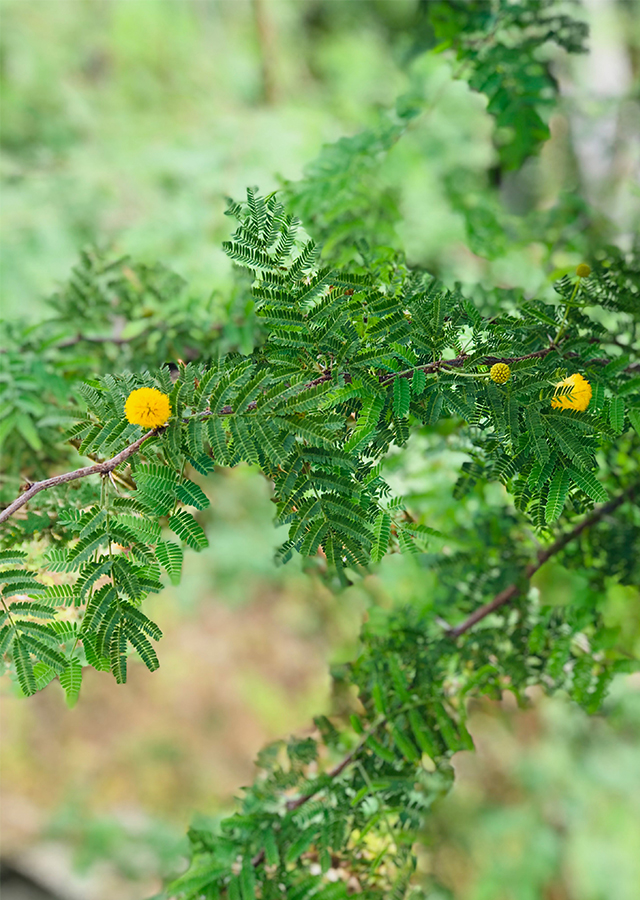Sweet Acacia
Vachellia farnesiana (L.) Wight & Arn.
Fabaceae
Location in our garden
Principal



Synonym
Acacia farnesiana (L.) Willd.
Mimosa farnesiana L.
Poponax farnesiana (L.) Raf.
Habitus
Shrubs. A perennial, deciduous shrub or tree with a wide low crown, can grow up to 2 - 7 m tall.
Part Used
Leaves
Bark
Flowers
Roots
Growing Requirements
Full Sunshine
Drought Resistant
Habitat
Shrublands
Grassland
Overview
Possibly native to tropical America, from Brazil and Peru to Mexico and the southern United States, sweet acacia has been widely planted throughout the world, being naturalized in many nations. However the exact status in the Caribbean is still uncertain, with it being noted in neighboring islands as both native and exotic. In both its native and introduced ranges, it is present in a number of habitats. The oil obtained is commonly used in perfumery.
Vernacular Names
Mimosa bush (Australia), Espinilha (Brazil), Acacie odorante (French), Antillen akazie (Germany), Dei-babul (India), Acacia farnese (Italy), Aroma (Spanish), Opoponax (USA).
Agroecology
Originally tropical, from the warm temperate to tropical regions. Vachellia farnesiana will succeed, where it is naturalized at altitudes up to 400 m and
cultivated up to 1,200 m. A soft sandy loam and a very sunny location sheltered from strong winds are preferred. It grows best in areas where daytime
temperatures range from 20-32 °C per year. With pure sand, plants can grow well.
Morphology
- Roots - taproot with a lot of lateral roots.
- Stems - slightly rough stems are dark chocolate brown or grey, many branches, many slender stems and long thin branches rising from ground level.
- Leaves - twice pinnate, with a small gland on petiole and sometimes one on the rachis near top of pinnae.
- Flowers - glabrous, leathery, in axillary pedunculate heads, calyx and corolla glabrous, scented.
- Fruits - pod indehiscent, straight or curved pods, 4-7.5 cm long, about 1.5 cm wide, subterranean and turgid, dark brown to blackish, glabrous, finely striated longitudinally, pointed at both ends.
- Seeds - brown, in two rows, embedded in a dry spongy tissue, smooth, elliptic, thick.
Cultivation
- Seed - best sown in a sunny position as soon as it is ripe. The seed germinates at 25 °C within 3 - 4 weeks.
- Cuttings of half-ripe wood in the frame with a foot.
Chemical Constituents
Metsulfuron-methyl, glyphosate, triclopyr, 2,4-D, tebuthiuron, hexazinone, phenols, alkaloid, haemagglutinin, tannin and gallocatechin.
Traditional Medicinal Uses
- Astringents, demuclents, anti-inflammatory and antiseptic properties are available.
- The bark is demulcent and astringent. It is used in cough therapy.
- The flowers were used as an antispasmodic, emetic, stomach and stimulant.
- Tender leaves are bruised with a small amount of water and then swallowed as a remedy for gonorrhea and bladder disease.
- A decoction of the leaves, after which the young leaves are then applied as a poultice, is used as a wash to treat ulcers and sores.
- In the treatment of dysentery and inflammation of the skin and mucous membranes, a decoction of the green seedpods was used.
- The gummy roots were chewed for sore throat treatment.
- The woody branches are used as toothbrushes in India
Part Used
Reference Sources
- Evangelia, P., Constantinos, V., Maria, C., Olga, T. (2017). Study of Volatile Components of Acacia farnesiana Willd. Flowers. Rec. Nat. Prod. 11:5 474-478.
- Hernandez-Garcia, E., Garcia, A., Garza-Gonzales, E., Avalos-Alanisa, F.G., Rivas-Galindoc, V.M.R., Rodriguez-Rodriguez, J., Alcantar-Rosalense, V.M., Delgadillo-Pugaf, C., Camacho-Corona, M.R. (2019). Chemical composition of Acacia farnesiana (L) wild fruits and its activity against Mycobacterium tuberculosis and dysentery bacteria. Journal of Ethnopharmacology 230: 74-80.



